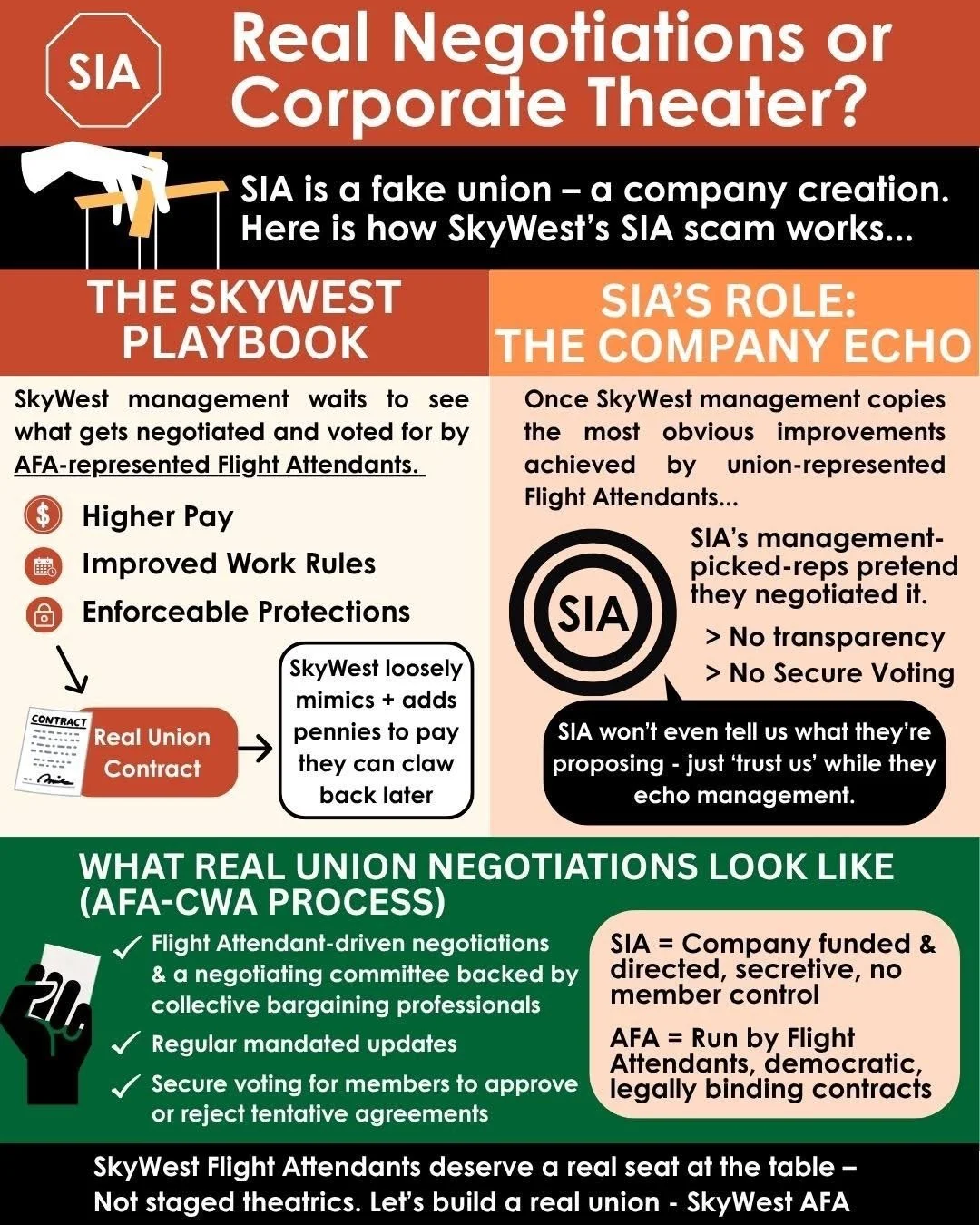Negotiations? What Negotiations?
At the end of December, SkyWest Flight Attendants’ pay scale lapses, which means negotiations should be in progress, right? Naturally, Flight Attendants are anxious to hear how it’s going. But questions about the negotiations on the SWOL Forums and social media have been met with silence from SIA board members, or with claims of “confidentiality.” Confidentially, from whom? Their own members, whom they are supposed to be representing in negotiations with the company? Where’s the transparency? Why are they refusing to keep their members updated?
Why have so many former SIA reps joined SkyWest AFA? Because once inside, they saw the truth: SIA exists to serve management’s agenda—not ours.
Historically, SkyWest management has liked to wait to see what the real unions that represent other regional Flight Attendants negotiate for their members so they can offer pennies more to us to claim “top pay,” claw back any money spent on raises in other ways (remember when bonuses used to mean something?), then SIA sells it to us as the result of their “negotiations.”
That’s not how real representation works.
If SkyWest Flight Attendants were represented by a real union that answered to us, contract negotiations would look very different.
According to the Association of Flight Attendants (AFA) Constitution and Bylaws, contract negotiations and ratification follow a clear, transparent step-by-step process.
Nine months before it’s time to submit a contract proposal to management, a Negotiation Committee is appointed by the airline’s Master Executive Council. Any member (Flight Attendant) can serve on the committee, not just council members and officers. The selection process is transparent and open to input from Flight
Attendants.All members of the Negotiating Committee must complete a Negotiations Training seminar. They survey all Flight Attendants to make sure they understand the priorities and concerns of the people they are representing. They are required to be up-to-date on union policy, company financial conditions, and industry developments.
Throughout the entire negotiating process, they must provide regular updates to members through means like continuing surveys, roadshows, and other updates to ensure Flight Attendants’ voices are always at the forefront to set the priorities.
No less than four months before the current contract “becomes amendable” (airline contracts don’t expire, they “become amendable” on whatever date the last contract agreed on), the Negotiating Committee meets to draft, with the guidance of a professional staff negotiator from the AFA, the “contract opener” or first proposal to management. At least 60 days before the contract is amendable, they exchange openers with the company, with the goal of concluding negotiations and ratifying a new contract before the current contract's amendable date. All bargaining with the company happens under the framework of the Railway Labor Act.
During this time, visible member support and solidarity actions are critical to strengthen leverage at the table. That means negotiations aren’t just locked away in a room somewhere in corporate headquarters. Members work with their negotiating team to make sure their voices are not ignored by management. Picketing (different from striking as it is done off-duty and with no work stoppage, and often done in solidarity with other airlines’ Flight Attendants from around the AFA or even with other unions), public relations, Zoom meetings, airport visibility blitzes are all part of the process to make sure not only that Flight Attendants know what their Negotiating Committee is proposing on their behalf, but that the Committee is listening to Flight Attendants.
When the Negotiating Committee and management reach a Tentative Agreement (TA), it is submitted to the Flight Attendants membership for approval.
Flight Attendants vote to ratify the TA. If members vote NO, the Committee goes back to the table, or if the members aren’t happy with the Committee, a new Committee may be chosen. Bottom line, it’s the members who decide when a TA is good enough to be ratified. Not the Negotiating Committee, not the international union, and certainly not the company.
Once a TA is ratified by a majority vote of the Flight Attendants, it is sent to the International President to sign for final binding approval.
After ratification, a real union’s work is far from done. AFA conducts education campaigns to ensure Flight Attendants know their rights. Local and MEC leaders receive training on grievance procedures. Within six months, committees and attorneys conduct compliance checks on company practices to hold the company accountable to the contract.
This is the process we should be seeing right now from the organization that claims to be our labor organization negotiating on our behalf. Transparency. Engagement. Solidarity. But with only three months to go before our pay scale lapses, we have absolutely nothing from SIA. A negotiating team that was selected behind closed doors with no input from Flight Attendants. Questions about the proposals SIA is putting forth to the company met with silence or claims of “confidentiality.” No visibility campaigns in airports or online. Just the uneasy sense that we won’t get a new pay agreement until the company knows what real unions have bargained for at other regionals so they can claim “top pay” without actually listening to us and what we really want. And we won’t know what they will quietly take back from us to offset whatever more we might get in hourly pay.
SkyWest Flight Attendants deserve better. We deserve representation that is transparent and open, that listens to us and works for us, not the company. We deserve an actual seat at the table. Instead, we have a “labor organization” that claims to represent us but operates in secret and is paid for by the same company they’re supposedly in talks with.
That’s not a negotiation. That’s a fiat.


